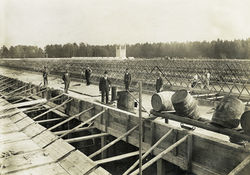
Industrial Design and Construction, 1907-1908

When large industrial facilities were built in the early 20th century, much of the old methods were used--manual labor, bricklayer crews, long aprons, wheelbarrows, and teams of spademen from local villages. But new revolutionary technologies were already emerging: reinforced concrete, cement mixers, skylights, and mechanical pile drivers to name a few.
There was also a new approach to industrial design, unprecedented quality and structural strength of the construction, and distinct early 20th century aesthetics even in the most utilitarian construction components. This exhibition is about one such facility, a textile factory built in Russia in 1907-1908.
A commissioned photographer documented all stages of the factory's construction over the period of two years, from underground tunnels to hanging gardens and individual lockers for workers, a novelty in factory operations at the time. Along the construction stages, the photos show the people who made this factory possible--managers and engineers, bricklayers and electricians, firefighters and security guards.
The factory is still operational today, its skylight roof remains a high standard for natural light use in industrial design, and the looms installed in 1908 successfully served until early 1960s.





































